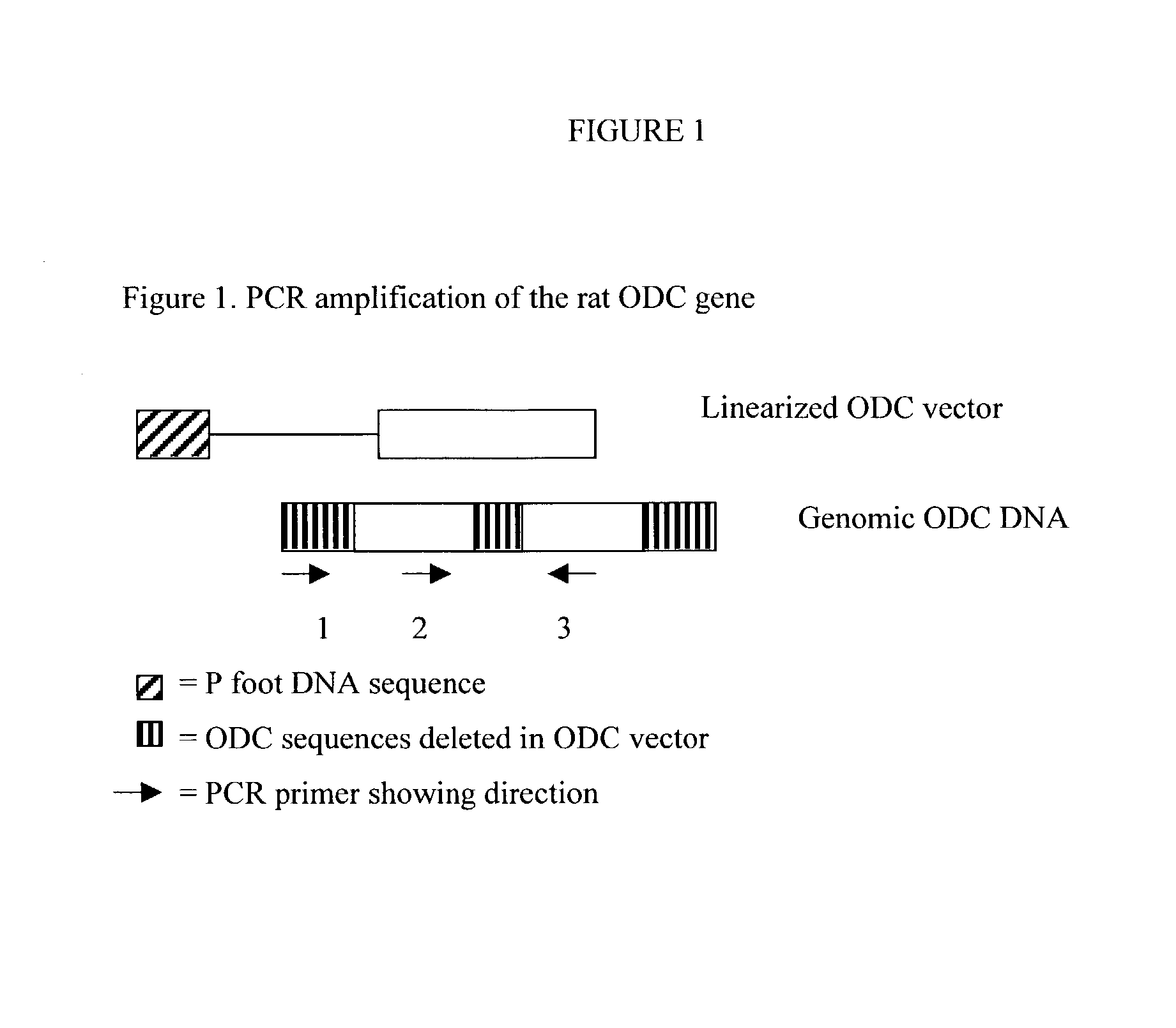Methods and compositions for use in homologous recombination
a technology of homologous recombination and composition, applied in the field of nucleic acid integration, can solve the problems of limiting the utility of this gene targeting approach, low absolute frequency of favorable events remains a serious limitation,
- Summary
- Abstract
- Description
- Claims
- Application Information
AI Technical Summary
Problems solved by technology
Method used
Image
Examples
example 1
Gene Targeting of the Ornithine Decarboxylase Gene of Rat Using a Circular Gene Targeting Vector
[0102] To demonstrate this strategy is successful, a circular gene targeting vector was constructed. The circular vector contained a single Drosophila P element transposase cut site (P foot) and a fragment of altered rat genomic DNA. The rat ornithine decarboxylase gene (odc) was chosen because its entire sequence was known and it was commercially available. In order to assay the integration of the vector, three small deletions were made in the odc gene of the vector. The small deletions were in the 5' end, 3' end, and the middle areas of the gene. One control vector contained the E. coli .beta.-galactosidase gene in place of the modified odc gene was also made. This control vector contained no known sequences of significant homology with the rat genome. Rats were co-injected with fifty micrograms of the circular odc / P foot gene targeting vector and ten micrograms of plasmid DNA that enco...
example 2
Gene Targeting of the Whey Associated Protein (WAP) Gene of Mice Using a Circular Gene Targeting Vector
[0105] To demonstrate this strategy is also successful in mice, a circular gene targeting vector is constructed. The circular vector contains a single Drosophila P element transposase cut site (P foot) and a fragment of altered mouse genomic DNA. The mouse Whey Associated Protein gene (WAP) is chosen because its entire sequence is known. In order to assay the integration of the vector, two small deletions are made in the WAP gene of the vector. The small deletions are at the 5' end and the 3' end of the gene. The E. coli .beta.-galactosidase gene with a constitutively active mouse promoter is cloned into the middle of the modified WAP gene. Mice are co-injected with ten micrograms of the circular WAP gene targeting vector and two micrograms of plasmid DNA that encodes the P element transposase and circular negative control plasmids. After three months, genomic DNA is prepared from ...
example 3
[0107] The WAP vector is modified as follows: the .beta.-galactosidase gene is removed, a small deletion in the middle of the WAP gene is made, and the P foot DNA sequences are deleted. This vector is linearized by subjecting the DNA to the restriction endonuclease, SspI. This linear DNA is injected into the mice and analyzed similarly as described in Example 2. The DNA integrates homologously into the WAP gene in all tested tissues in the injected animals as well as giving rise to progeny with a genetically altered WAP gene.
PUM
| Property | Measurement | Unit |
|---|---|---|
| pH | aaaaa | aaaaa |
| weight | aaaaa | aaaaa |
| weight | aaaaa | aaaaa |
Abstract
Description
Claims
Application Information
 Login to View More
Login to View More - R&D
- Intellectual Property
- Life Sciences
- Materials
- Tech Scout
- Unparalleled Data Quality
- Higher Quality Content
- 60% Fewer Hallucinations
Browse by: Latest US Patents, China's latest patents, Technical Efficacy Thesaurus, Application Domain, Technology Topic, Popular Technical Reports.
© 2025 PatSnap. All rights reserved.Legal|Privacy policy|Modern Slavery Act Transparency Statement|Sitemap|About US| Contact US: help@patsnap.com

